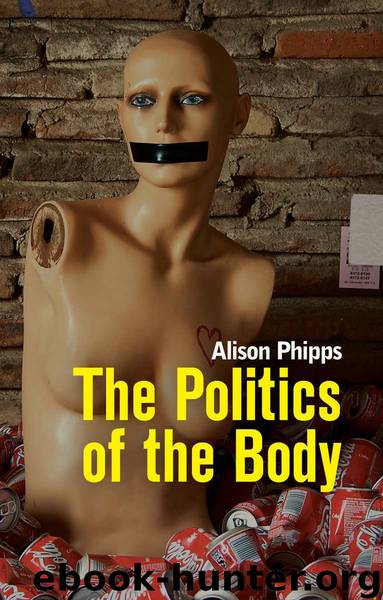The Politics of the Body: Gender in a Neoliberal and Neoconservative Age by Alison Phipps

Author:Alison Phipps [Phipps, Alison]
Language: eng
Format: epub
Publisher: Wiley
Published: 2014-04-10T00:00:00+00:00
‘Normal birth’ and ‘breast is best’
In their resistance to the language of medicalization, feminists and other activists have tended to employ the idiom of the ‘normal’ or the ‘natural’ (Beckett 2005). In the late 1980s and early 1990s, this language was institutionalized when the World Health Organization (WHO) adopted a definition of ‘normal birth’. This was premised on the belief that interventions, although helpful in some cases, were unwelcome in non-complicated labour and delivery (World Health Organization 1996; Chalmers and Porter 2001). The definition of ‘normal birth’ was ‘[s]pontaneous in onset, low-risk at the start of labour and remaining so throughout labour and delivery. The infant is born spontaneously in the vertex [head first] position between 37 and 42 completed weeks of pregnancy. After birth, mother and infant are in good condition’ (World Health Organization 1996: 4). In such low-risk situations, the WHO argued, women should not be subject to major interventions unnecessarily: in normal birth, there should be a valid reason to intervene in the natural process (World Health Organization 1996: 4).
By the 2000s, the concept of ‘normal’ or ‘natural’ birth had become common parlance among birth activists and health professionals in western countries. However, ‘normalcy’ by this point had become a target to achieve: a desired outcome rather than a designation of low-risk status implying that efforts should be made to avoid unnecessary procedures. From 2003 to 2006, ‘normal delivery’ rates were published annually in England by the National Health Service Information Centre (National Childbirth Trust 2010). In 2007, a report by the UK Maternity Care Working Party, which included the Royal College of Midwives, the Royal College of Obstetricians and Gynaecologists, the National Childbirth Trust, the Association of Radical Midwives and BirthChoiceUK, said that maternity services should aim to increase their ‘normal birth’ rates to 60 per cent by 2010. ‘Normal birth’ was defined as being ‘Without induction, without the use of instruments, not by caesarean section and without general, spinal or epidural anaesthetic before or during delivery’ (UK Maternity Care Working Party 2007: 1). This was exemplified by women whose labours began spontaneously and progressed spontaneously without drugs, and who gave birth spontaneously.2 In all four countries of the United Kingdom, maternity policy in the 2000s was directed towards promoting ‘normal birth’ and reducing interventions (National Childbirth Trust 2010). The idea of ‘normal birth’ was also being promoted in other European countries, North America and around the world in similar ways (Hendrix 2011). In the United States, the 1989 revision of the Standard Certificate of Live Birth had introduced new items on obstetric procedures and method of delivery as a means of monitoring uses of technology during labour (Freedman et al. 1988), and the caesarean rate had been a matter of concern since the late 1970s (Menacker 2005).
A shift had occurred, from the feminist-inspired aim of protecting women from the process of medicalization to the more neoliberalized practice of using ‘normal birth’ as an indicator and target and promoting ‘normalcy’ of outcome: within this new framework, there was a clear preference for particular types of birth over others.
Download
This site does not store any files on its server. We only index and link to content provided by other sites. Please contact the content providers to delete copyright contents if any and email us, we'll remove relevant links or contents immediately.
On the Front Line with the Women Who Fight Back by Stacey Dooley(4699)
The Lonely City by Olivia Laing(4572)
The Rules Do Not Apply by Ariel Levy(4529)
Bluets by Maggie Nelson(4268)
The Confidence Code by Katty Kay(4041)
Three Women by Lisa Taddeo(3281)
Inferior by Angela Saini(3152)
Not a Diet Book by James Smith(3152)
A Woman Makes a Plan by Maye Musk(3146)
Confessions of a Video Vixen by Karrine Steffans(3104)
Pledged by Alexandra Robbins(3050)
Wild Words from Wild Women by Stephens Autumn(2939)
Nice Girls Don't Get the Corner Office by Lois P. Frankel(2936)
Brave by Rose McGowan(2738)
Women & Power by Mary Beard(2621)
The Girl in the Spider's Web: A Lisbeth Salander novel, continuing Stieg Larsson's Millennium Series by Lagercrantz David(2614)
Why I Am Not a Feminist by Jessa Crispin(2587)
The Clitoral Truth: The Secret World at Your Fingertips by Rebecca Chalker(2586)
Women on Top by Nancy Friday(2449)
